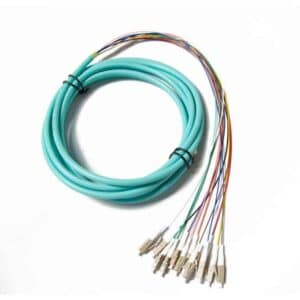Fiber Optic Pigtails
One fiber optic connectors vs. multiple fiber optic connectors
Fiber optic pigtails are critical components of large-scale fiber optic networks. Unlike fiber jumper cables, which have factory-installed connectors at both ends, pigtail patch cords have only one connector — the other end is unterminated fiber.
Multi strand pigtails contain multiple, tightly buffered fibers in a cable jacket that can be easily cut, spliced and terminated. This allows organizations to quickly customize and deploy pigtail fiber cable for network terminal applications. Instead of finding the right connector for each end of the jumper cable, companies can simply cut and splice pigtails on demand.
Use of Fiber Optic Pigtails Cable
Not every industrial or manufacturing application requires a fiber patch cord with pre-terminated connectors on both ends. In many cases, companies only need factory-installed connectors at one end. At the other terminal, it’s easier to leverage fusion or mechanical splices across digital connections, especially if they’re part of a larger panel, network or fiber optic deployment. Pigtail solutions are also ideal when running the fiber cable through tight spaces and innerducts.
Is cutting fiber optic patch cords a good idea?
While it’s possible to simply purchase and cut a fiber optic patch cord with connectors on both ends into two pigtail fiber optic cables, this presents two potential problems — cost and complexity. Dual-connector cables are often more expensive than their pigtail counterparts, and imprecise cuts to existing patch cords could cause pigtail fiber failures. A purpose-built pigtail patch cord ensures you get the performance and throughput you need for high-value fiber optic applications.
Advantages of fiber optic pigtails
A multi strand fiber optic pigtail cable makes it easy to route large strand volumes through a protected pathway or length of innerduct with easy connections at one end and multiple splice options at the other. This provides greater flexibility for high-volume applications such as telecoms signaling or industrial device controls along with a reduced cabling footprint, since multiple strands can be deployed within a single jacket.
Female and Male Connectors
Fiber optic pigtails have two different types of connectors: female and male. Female connectors can be attached in a patch panel, which is often done in pairs. It is also possible to attach a single-fiber female connector to an endpoint or another fiber run with patch fibers. Male connectors plug directly to an optical transceiver.
Finding Your Best-Fit Fiber Optic Pigtails
At Amerifiber, we offer both multimode and single mode fiber optic pigtail solutions to meet your network needs. Our multi-strand multimode pigtails are available with LC, SC, ST, FC and MPO connectors for both 62.5/125 and 10gig applications, while our multi-strand single mode pigtails include SC, LC, ST, FC, MU, and MPO options and are available with UPC or APC ferrules.
Which connector do you need?
As we just mentioned, there are several different types of fiber optic connectors available. Which one is right for you depends on the type of fiber being installed and the equipment. Of course adapters are always an option, however, it’s easiest to simply determine both the fiber and connector needed ahead of time. Keep in mind that for networking and audio/video, three most popular connectors in the US are LC, SC and ST, with LC and SC being most commonly used.
Multimode fiber optic pigtails vs. single mode fiber optic pigtails
Not sure which is the best fit for your application? Use your data volumes and distances as a guide. Multimode pigtails deliver higher-volume transfers by using larger-diameter glass strands. But over large distances, these multimode fiber optic signals start to refract and degrade. Single mode pigtails leverage much smaller core fiberglass strands to deliver high-quality, smaller-volume data output over greater distance.
Tight-buffered vs. loose-tube fiber optic cables
Two main types of fiber optic cables are tight-buffered and loose-tube. Although both have a strengthening component (like stainless steel wire strands, gel-filled sleeves or aramid yarn), they are not meant for the same environment.
Tight-buffered cables
Tight-buffered cables are sturdy and work best with indoor applications. They’re well-suited for moderate lengths LAN/WAN connections, long indoor runs or even direct burial and underwater applications.
Tight-buffered cables’ coating consists of two layers: plastic and waterproof acrylate. There’s no gel layer to protect the fiber core. Instead, the acrylate coating keeps the core dry, even when the cable is bent or compressed.
Tight-buffered cables are easy to install since they do not require a gel (that needs to be cleaned up) or a fan-out kit for splicing or termination.
Loose-tube Cables
Loose-tube cables were designed for outdoor use and to withstand harsh environments. They are the older of the two types of cables. Loose-tube cables include a semi-rigid protective sleeve or tube to protect the fiber core, cladding and coating. If a loose-tube cable has more than one optical fiber, each one has an individually-sleeved core. These cores are then loosely bundled into an outer jacket.
Water-resistant gel is often used in loose-tube cables to protect the fibers from moisture. This gel makes the loose-tube cables a good choice for environments where humidity and condensation are an issue. Additionally, gel-filled tubes can expand and contract with temperature.
Go Further With Fiber Optic Pigtails
At Amerifiber we’re committed to crafting and delivering the highest-quality fiber pigtail options on the market. With durability and reliability that’s second to none — and more than 30 years of experience in the industry — it’s our goal to deliver the best and most competitive prices for every product we supply. We custom build every cable to the clients’ specifications to best fit the application.
Improve your network output and optimization with the right fiber pigtail products. Connect with Amerifiber today. We offer a wide variety of fiber optic management equipment.


